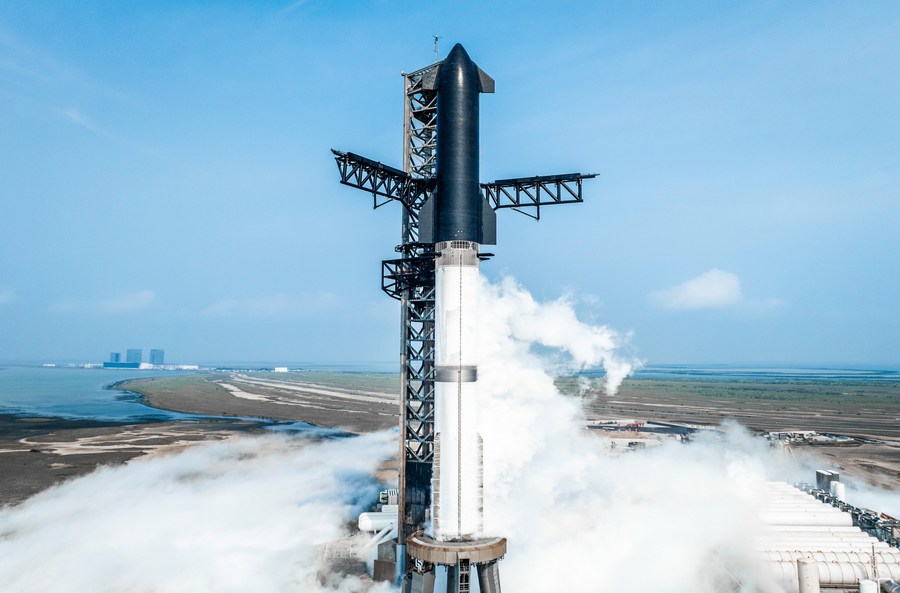During its fourth test flight, SpaceX’s massive Starship rocket launched from south Texas on Thursday and made a splashdown landing in the Indian Ocean after surviving reentry through Earth’s atmosphere.
In March, the spacecraft broke apart during its final effort to survive a scorching hot reentry through Earth’s atmosphere. The spacecraft was made up of two stages, with the Starship cruise vessel atop its massive Super Heavy rocket booster.Yet, a SpaceX livestream on Thursday demonstrated that the craft made it during its reentry.
“Despite loss of many tiles and a damaged flap, Starship made it all the way to a soft landing in the ocean!” Following the splashdown, Elon Musk, the CEO of SpaceX, tweeted on social media. On Thursday morning, Starship, with its Super Heavy booster atop it, took off from the Starbase launch site located close to Boca Chica Village on the Texas Gulf Coast. This is the most recent trial mission in Elon Musk’s company’s test-to-failure rocket development campaign.
Three minutes into the flight, several of miles above Earth, the rocket system’s first stage, dubbed Super Heavy, separated from the Starship upper stage, launching the spacecraft toward orbit.Super Heavy seemed to make a smooth landing in the Gulf of Mexico as it made its way back toward land. Starship, on the other hand, fired up its engines to start the roughly seventy-minute journey around the world into the Indian Ocean.
The opening of a Costco store in a tiny rural town north of Tokyo last year had enormous impact on the local economy and possibly the entire country of Japan.It started its free fall back to Earth there, when it was subjected to the extreme heat of atmospheric reentry, which proved to be the critical moment when it failed in March.
Starship, which stands about 400 feet (122 meters) tall and is intended to be more powerful and less expensive than SpaceX’s reliable Falcon 9 rocket, is a representation of the company’s dominant satellite launch and astronaut business going forward. NASA plans to utilize it in the next years to send the first humans to set foot on the moon since 1972.
Every Starship rocket has exceeded earlier testing goals in terms of distance traveled before failing either by exploding or dissolving in the atmosphere. Minutes after takeoff, the rocket exploded in April 2023, about 25 miles (40 km) above Earth. Starship made its maiden trip into space in November of that year, but it burst shortly after.
In March, Starship attempted to return from orbit halfway around the world on its most recent voyage, but it only managed to go considerably farther before breaking apart in Earth’s atmosphere. The rocket’s Thursday launch was a rerun of its earlier test, although it was intended to travel farther. Hundreds of tiny black tiles cover the rocket, which is intended to shield it from the intense heat it will experience when it accelerates through Earth’s atmosphere at hypersonic speeds. Musk, the CEO of SpaceX, stated on social media on Saturday that “the main goal of this mission is to get much deeper into the atmosphere during reentry, ideally through max heating.”
Much depends on SpaceX’s development of Starship, which NASA depends on as it competes with China, which intends to send people to the moon by 2030, and return humans there in 2026. China’s lunar program has advanced recently in a number of ways, including the successful landing of a sample retrieval mission on the moon’s far side.
Though Starship’s development has seemed to move more quickly than other rocket programs, it has progressed more slowly than Musk had anticipated. Citing scheduling concerns, a Japanese millionaire who had originally paid to pilot Starship around the moon canceled his voyage last week. Additionally, according to a Reuters investigation, Musk’s determination to develop Starship quickly has put SpaceX employees in risk in Texas and California.
